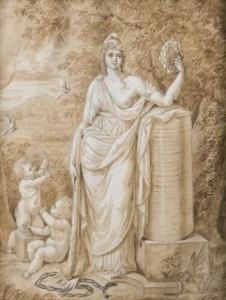Jean-Guillaume Moite Paintings
Jean-Guillaume Moitte was a French sculptor born on November 11, 1746, in Paris, France. He is not to be confused with another French artist, Jean-Guillaume Moitte (1743-1806), who was an engraver. The sculptor Moitte was a student of the renowned Jean-Baptiste Pigalle and later, Jean-Baptiste Lemoyne, two prominent figures in French sculpture during the 18th century. Moitte was a quintessential artist of the Neoclassical movement, which sought to revive the styles and principles of ancient Greek and Roman art, characterized by its emphasis on simplicity, harmony, and proportion.
Moitte won the prestigious Prix de Rome in 1768, which allowed him to study at the French Academy in Rome from 1770 to 1773. During his time in Italy, he was heavily influenced by the classical art and architecture of antiquity, which greatly shaped his artistic style. Upon his return to Paris, he became a member of the Académie Royale de Peinture et de Sculpture in 1783 and later a professor at the Académie des Beaux-Arts.
Throughout his career, Moitte created numerous sculptures, many of which were commissioned by the French government during the time of the Revolution. His works include reliefs for the pediment of the Panthéon in Paris, decorative sculptures for the Château de Fontainebleau, and designs for the Place de la Concorde. He also contributed to the artistic projects at the Louvre Palace, where his works helped to transform the former royal residence into a national museum.
Moitte's style is marked by its elegance and adherence to classical forms, and his sculptures often exude a sense of calm restraint and noble simplicity. Despite the political turmoil of his time, including the French Revolution and the rise and fall of Napoleon, Moitte continued to receive commissions and remained an influential figure in French sculpture.
He died on May 2, 1810, in Paris. Today, Moitte's works can still be seen as part of the architectural fabric of Paris and in various museum collections. He left behind a legacy that continues to be appreciated for its embodiment of Neoclassical ideals and its contribution to the aesthetic transformation of Paris during a time of profound change.
